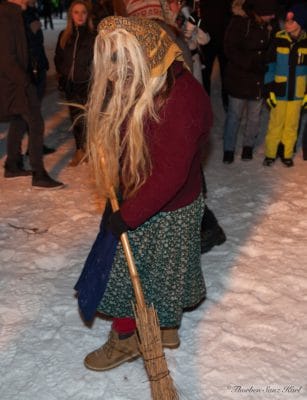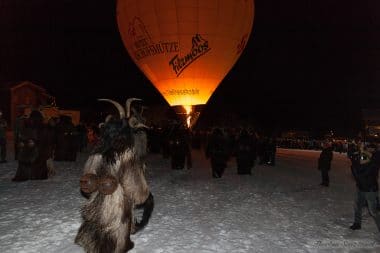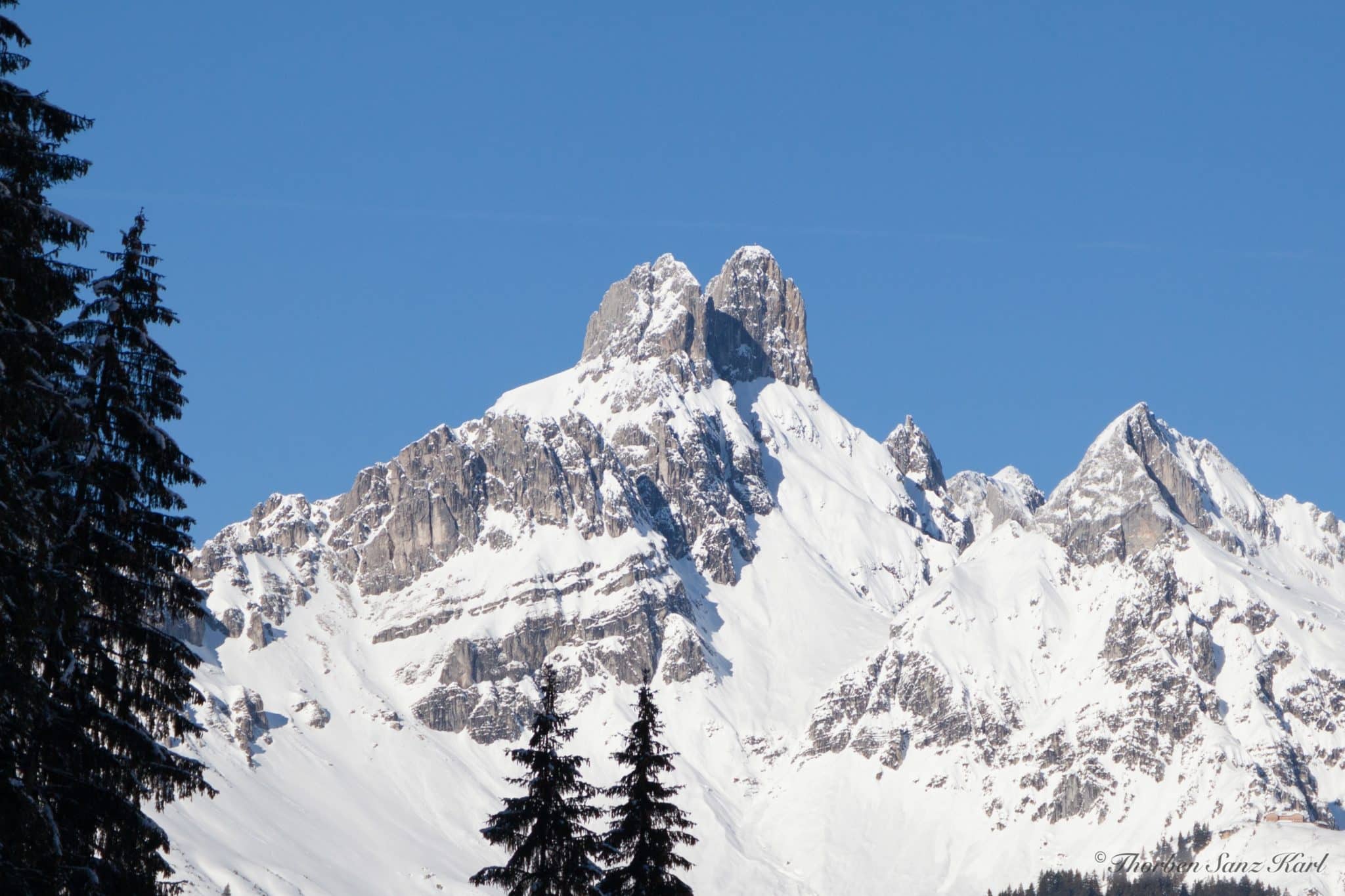
Filzmoos’ legend begins with the sound of a bell. When they searched for the origin of the sound, two shepherds found a carved statue of Jesus as a child, dressed in magnificent robes, standing on a tree stump. In his hands the figure held a globe and a bell. It stood there in the middle of nowhere on a tree stump and had raised its bell-bearing hand in blessing.
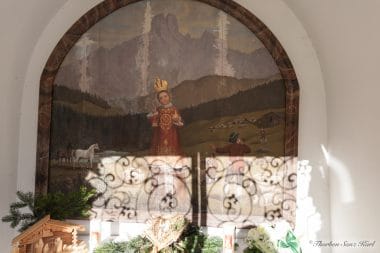
The shepherds brought the sculpture to a church in nearby Altenmarkt. Overnight, however, the sculpture disappeared again. It was found again at its previous position, on the tree stump. The baby Jesus was then taken to St. Peter’s Church in Vienna , where he stayed.
At the place where it was found and to which it had returned, the Filzmoos original chapel stands today. A small building in which a painting of the baby Jesus can be seen. The figure can be admired in the Filzmoos pilgrimage church.
The ski slopes in Filzmoos
In Filzmoos, Austria , there are several downhill runs. Visible from Filzmoos are the Großberg, the Papageno and the Bögrain. It is important to know that ski slopes are usually divided into colours depending on the level of difficulty and marked with signs. Blue stands for easy, red for medium and black for hard.
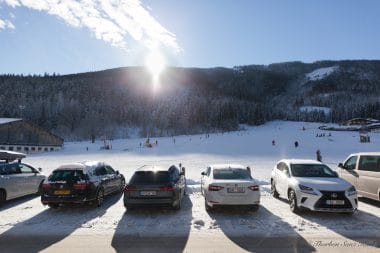
The Bögrain is a comparatively flat slope classified as blue with a drag lift and perfect for practicing skiing as a beginner. By the way, from here you can also ski comfortably to the Papageno valley station and save yourself a walk in ski boots.
Then there is the descent on the Großberg. From the mountain station of the Großbergbahn, which is a four-seater chairlift, there are several ways down. There are blue routes here, some of which are a bit more demanding than the Bögrain Slope, but also a few red sections. For a few years now, there has also been the “Michaela Kirchgasser FIS course”, named after the local Michaela Kirchgasser, who won World Cups in slalom and giant slalom, among other things. FIS stands for Fédération Internationale de Ski and is the International Ski Federation. This FIS course is classified as black and requires a lot of skill and skill to get elegantly from the beginning to the end of the section. The last slope of the Großberg may seem steep, but it is classified as blue. If you want it to be as flat as possible here, you should stick to the right side of the slope. It is less steep than the left side.
Once you have descended the Großberg a bit, you can find a connecting route that takes you to the Mooslehen lift, and a T-bar lift that takes you back to the Großberg. The Mooslehen slope has both blue and red sections and offers a pleasant change from the Großberg. From the Mooslehen, however, you can still get to the Schwaigalm lift, and the Schwaigalm, and the red slope of the Geierberg by means of a blue slope. Both are T-bar lifts and the Schwaigalm lift also takes you back to the Mooslehen.
Near the village square of Filzmoos is the Papageno Bahn, a cable car that takes you to the Papageno, which is classified as red, and to the Schörgi Alm. As the red suggests, the descent is a bit more demanding and, above all, takes a little more time. From the final slope of the slope you also come back to the Bögrain.
Skiing for young and old in Filzmoos
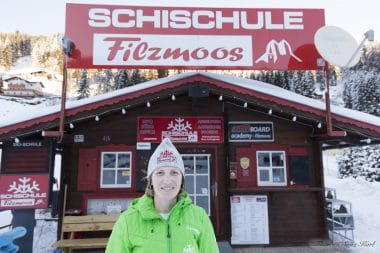
If you want to learn to ski or snowboard, there is a surprisingly large selection of ski schools in Filzmoos for a rather small town. Three, to be exact. The Exklusiv Ski & Snowboard School, the Bögei Ski School and the Filzmoos Ski School, which also includes the Filzmoos Snowboard Academy.
You might think that so many companies with the same concept in such a small space are a bit many. Ilona Schörghofer, head of the Filzmoos ski school, thinks it’s nice that guests in Filzmoos have the opportunity to choose. And there are undoubtedly enough guests in the high season to make it worthwhile for everyone.
Food turns an excursion into a holiday
When you come back from skiing and hiking, you need exactly one. Delicious food!
Good food can be found everywhere in Filzmoos. But finding the best treats in the town’s well-stocked menus requires a certain amount of luck and skill.
In the heart of Filzmoos, there is already a lot of delicious food right on the village square. The Pizzeria Pinocchio reliably supplies you with delicious stone-oven pizza. Whether you go to the restaurant or order for a cozy evening in the accommodation of your choice.
The star hotel Hanneshof also delights you with star-worthy food. And also with atmosphere. The pine parlour in the house is a nice place to have a meal. The room exudes a friendly and inviting fireplace atmosphere, with the light wood paneling, the decorations and the impressive stuffed animals and antlers displayed on one of the walls. However, if you want to dine in the Zirbenstube, it is advisable to reserve a table, as the popular seats are quickly all occupied. Particularly worthwhile here are the changing dinner menus, as they never disappoint, or the Hong Kong plate, which seems even more exotic between the local food. And for celebrating and enjoying, the Hanneshofplatte is ideal for 2 people or more, a combination of different types of meat and vegetables and several side dishes.
In the house of the Hanneshof there is a butcher who partially supplies the Hanneshof. But you can also pre-order a grilled chicken from him yourself, for example.
The Bischofsmütze restaurant offers extremely fresh fish, in front of the restaurant you can still look at the trout in the aquarium, and good meat. And fantastic garlic bread, if you like it. This is available, for example, with the spare ribs, from which everyone is now really full, because the portion is impressive.
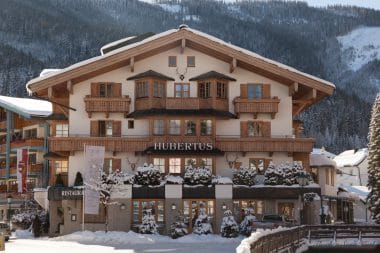
The Hubertus serves dishes by Michelin-starred chef Johanna Maier. This sets expectations high, but it is safe to say that these expectations will be exceeded. However, the kitchen is exclusive for house guests and only available for others on special request.
And then there is the Fiakerwirt, whose grounds are not only teeming with cuddly rabbits and where you can also rent a nice carriage ride, but also serve you a Wiener Schnitzel the size of a plate.
And that was only the town centre. If you search a little further, you will quickly find La Vie, where you will be cooked by Ivan, who has been cooking in Filzmoos for years before moving into this kitchen and who has internalized his recipes so much that every time I eat with him, they taste better than the nostalgic thought of them. La Vie offers a wide range of dishes. On special occasions I can recommend the Tatar hat. This is a cast-iron hat with a brim, which is equipped with small hooks on which you can hang meat. The brim is filled with vegetables and broth and is ideal for tipping bread. There are also various sauces, of which I can’t determine the best one, as they are all delicious. If you want to try the Tatar hat, however, you have to order it in advance.
Then there is the Pilzstub’n restaurant, which shines with home cooking. Here I can especially recommend the vegetarian options. Both the mushroom risotto and the baked camembert are my go-to dishes here.
Of course, the feasting does not stop in the valley. The surrounding mountains are home to a number of alpine pastures. There is the Oberhofalm, which is easiest to reach by taxi or carriage from the Fiakerwirt, and the Unterhofalm, which is located slightly above the Oberhofalm in terms of altitude. However, the farms to which the two alpine pastures belong are again arranged the right way around. The alpine pastures are idyllically located a little deeper in the mountains by a small lake. In summer, you can walk well through nature and cow pastures on the landscaped paths. At Christmas time, there is the Christmas idyll here. A tour with small attractions. The alpine pastures are homely and persuade you to come back with delicious local dishes.
If you like to let your gaze wander over the mountains and the horizon, while enjoying a refreshing elderflower spritzer or a hot chocolate, the terrace of the Schörgi Alm at the Papageno gondola lift is the place where you want to be. And if it suits you, you can also upgrade your view with a hearty Brettljausen, i.e. delicious local breads with various cold cuts, or a Kaiserschmarren with apple sauce.
Then there is the Kleinbergalm at the Großbergbahn. The Filzmooser and their naming. The alpine pasture also has a beautiful sun terrace with a good view and also very tasty yeast dumplings, which you should have tried. But don’t underestimate the portion, this “dessert” makes you as full as a whole 2-course menu!
And if you are ever a guest at Gasthaus Wurzer, try one of the milkshakes!
Small place, big people
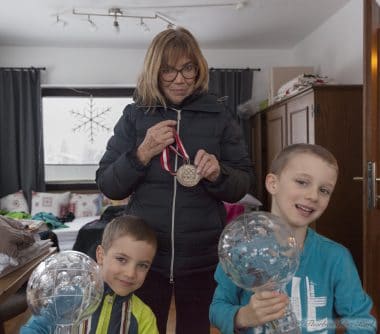
The name Schörghofer can be found a little more often in Filzmoos. Opposite the Großberg there is the Aparthotel Schörghofer, they own the Filzmoos ski school, the Schörgi Alm is run by the Schörghofers and then there is Philipp Schörghofer. He won the Alpine Ski World Cup in the giant slalom and two FIS World Ski Championships in the team competition with gold.
Another well-known name in Filzmoos is Michaela Kirchgasser, after whom even a separate section of the route in Filzmoos was named. Kirchgasser, also known as “Kirchi”, won three World Cup gold medals in slalom and giant slalom.
And because two world-class skiers are not enough, Brigitte Habersatter-Totschnig still lives in Filzmoos. Mrs. Habersatter-Totschnig won the Olympic silver medal in the downhill category in Innsbruck in 1976. In addition, she has won the Ski World Cup with gold a total of eight times! Seven times in the downhill and once in the giant slalom.
Despite the international fame, she would never have dreamed of moving away from Filzmoos, as she told me in the interview. Instead, during the last season of her career, she built a hotel and restaurant in Filzmoos with her husband, which was appropriately christened Olympia , and ran it for almost 39 years after ending her career until 2017 before selling it. Nowadays you can still spend the night there, but the restaurant has been converted into a café and a bed and breakfast for guests.
“For me, Filzmoos is the most beautiful alpine village in the world,” Mrs. Habersatter told me. She tells us how you can go on beautiful hikes in the surrounding mountains in summer and how you can ski just as you want in winter. “Filzmoos is not so crowded in winter. You can drive the way you want and you don’t have to take care of the other people as you do in other villages.”
In general, everyone I asked had something good to say about Filzmoos. Ilona Schörghofer loves to walk through “my our town” and thinks it’s nice that the centre of Filzmoos has been preserved over all the time that Filzmoos has existed.
Every year again – Advent season in Filzmoos
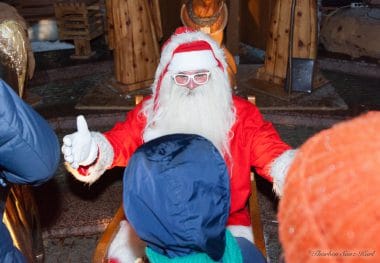
On Christmas Eve in the late afternoon every year, you can gather at the Filzmoos village square. Santa Claus comes there with the Christ Child and a few angels. The spectacle is especially nice for children, because after Santa Claus has read a story, they also get something sweet from the angels. While waiting for Santa Claus, you can get a mulled wine or a children’s punch and a fruit loaf. In addition, sparklers are distributed, which are lit when Santa Claus comes to the village square in his sleigh.
A popular, recurring tradition is the Perchtenlauf, which has been held annually in Filzmoos for over thirty years now. Perchten are creepy-looking figures that resemble the Krampus very much, but they have a few more horns. Despite their unfriendly appearance, the myth of the Perchten is a good-natured one. Perchten gather with large bells and march noisily through places to drive away the evil spirits and winter.
Perchten runners gather in clubs to maintain this very old custom. Some with masks and costumes that are more than a hundred years old. When I asked some Perchten why they take part in the runs, they told me, on the one hand to keep the tradition alive and on the other hand also because of the community. The clubs are a colourful mix of old and young. I talked to people over fifty, but also to an eleven-year-old girl who was enthusiastic about the production of the costumes. A chairwoman, i.e. an association leader, told me: “My grandparents were Perchten, my parents were Perchten and I and my husband are also Perchten. I’ve been doing this for 17 years, since I was 14, and I took over the management after my father. I couldn’t imagine not running as a Perchte. It’s just too good a time for all of us.”
Every New Year’s Eve, the Filzmoos ski schools organize a torch relay in which the ski and snowboard instructors ski down the final slope of the Papageno with torches. They put the number of the New Year in torches in the snow. It is definitely beautiful to see how up on the mountainside the year burns and announces the beginning of the new year. After that, there is always a speech by the ski school directors. If you’re lucky, you can get hold of one of the ski instructors’ torches and use it later to light your New Year’s Eve firecrackers.
by Thorben Sanz Karl


